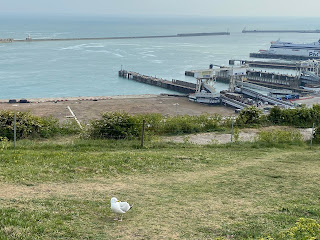I first saw a Chough a few years ago, in Cornwall. These elegant members of the crow family, recognisable by their glossy black plumage and red beak and feet, started to recolonise the clifftops of Cornwall in the early twenty-first century after an absence of many years. It’s the county bird there, due in part to its association with the King Arthur legend. Officially speaking, the Chough of which I talk is known as the Red-billed Chough, and it’s pronounced “chuff”. Although I knew the bird when I saw it, I only knew it from books and had to ask someone how it is pronounced.
The Chough also has associations with Kent. Somehow, it also became involved in the legends surrounding Thomas Becket, the Archbishop of Canterbury who was murdered in his own cathedral in 1170 — one of the most notorious events in English history, which led to Canterbury becoming a major pilgrimage destination in the Middle Ages. Some time after his murder and subsequent canonisation, Becket was retrospectively given a coat-of-arms depicting three Choughs, and this in turn has become the coat-of-arms of the City of Canterbury.
Quite why a clergyman who was born in London and died in Kent should have a Cornish bird associated with him is unclear; according to legend, one of them is supposed to have wandered into Canterbury Cathedral shortly after the murder.
I’ve been to Kent a few times for work over the past month, visiting Canterbury and also Dover, principally the castle as far as the latter is concerned but also taking in the National Trust’s site atop the White Cliffs, just along from the castle which is managed by English Heritage.
The views from the White Cliffs are amazing — the Port of Dover is laid out before and below you, Dover Castle (witter the church and the Roman lighthouse distinct from the central keep) on the horizon and the prospect of seeing France (just 21 miles away) on a clear day. It’s usually windy though! In terms of birds, there are plenty of gulls (particularly Herring Gulls) and crows (particularly Jackdaws), but also Blackbirds and Robins which are quite vocal and on one occasion I spotted a male Kestrel hovering in the wind, visible from the visitor centre.
And then there are the Choughs.
A very recent rewilding project has seen Choughs from Cornwall being reintroduced to the chalk cliffs of Kent, where they died out over two centuries ago as a result of habitat loss and persecution. With the chalk grassland having been restored in recent years through the work of organisations like the Kent Wildlife Trust and the National Trust, the habitat to support them in Kent is in place. A chick was hatched last year and managed to fledge, but was sadly lost in strong winds. Rewilding always has its ups and downs, but as was the case from my visit to Edinburgh the other month, it’s great to see that efforts are being made on a local level the country to help give nature as good a future as it can have.
I’m told that the best place to see the Kentish Choughs is in the area between the White Cliffs car park and the castle, and although I have yet to lay eyes on them in Kent I remain optimistic that I will do so at some point. Early morning is the best time apparently, although as I’m on a schedule for my visits to Kent I’m not usually there until the afternoon!




